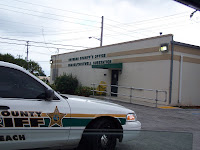Pompano Beach
Broward County, Florida
Dr. Martin Luther King Jr Boulevard
(formerly named: Hammondville Road and Third Street)
Zip Code: 33060
Overview:
MLK Blvd through Pompano Beach starts at Dixie Highway, which is the historical center of the city that divides east from west at the railway tracks. Heading west, it is a four-lane road with commercial zoning fronting the road. To the south is the commercial core of Pompano Beach, and immediately behind the commercial zoning to the north is a viable but hurting residential neighborhood. The locals, including the Black locals, still refer to this section of MLK Blvd as Third Street.
After about a mile one drives under the I-95 freeway (no entrance to freeway) and enters the industrial corridor. This section of MLK Blvd is still referred to by the locals as Hammondville Road. On both sides of the freeway the area has a hard-core inner-city feel to it and I would not be anywhere near here after dark. From here (the 1100 block) to the end, the area to the north is pure industrial, with the exception of the Sunshine Health Center at 1711 MLK Blvd. This is a health center that caters to Medicaid and Medicare recipients and also offers dentistry.  The area to the south is residential, and a sheriff’s substation is located on the corner of 18th Avenue.
The area to the south is residential, and a sheriff’s substation is located on the corner of 18th Avenue.
Once past Powerline Road (2100 block), you are in NIMBY land, where there are two strip joints and three prisons within blocks of MLK Blvd.
MLK Blvd ends at NW 31 Avenue, where there is a Florida Turnpike entrance.
Length:
Approximately 3 miles
·000 Block (Dixie Highway) to 3100 Block West.
Category:
Residential Neighborhood (houses fronting MLK Blvd) = 0%
Commercial Corridor: Main Street = 0%

Commercial Corridor: Mom & Pop Shops = 20%
·Blighted and Ignored = 30%
·Blighted but Not Ignored = 30%
·Gentrification Failing = 0%
·Gentrification Succeeding = 10%
·Viable with Room to Improve = 20%
·Vibrant and Car Friendly = 10%
· Vibrant and Pedestrian Friendly = 0%

Industrial Corridor = 80%
·Blighted and Ignored = 50%
·Blighted but Not Ignored = 30%
· Gentrification Failing = 0%
·Gentrification Succeeding = 10%
·Viable with Room to Improve = 10%
· Vibrant and Car Friendly = 0%
·Vibrant and Pedestrian Friendly = 0%
Community Assets:
1)  The E. Pat Larkins Community Center at 520 MLK Blvd. It is a brand new facility built in a relatively safe area. It seemed well staffed with a broad variety of programs for all age groups. (http://www.mypompanobeach.org)
The E. Pat Larkins Community Center at 520 MLK Blvd. It is a brand new facility built in a relatively safe area. It seemed well staffed with a broad variety of programs for all age groups. (http://www.mypompanobeach.org)
2)Churches: Along the length of the boulevard there were three significantly large and well maintained churches, and perhaps a half-dozen small “store-front” churches.
3)National Chain Grocery or Department Stores: None were encountered.
4) Brand Name Franchised Restaurants: At the far western end, where the ramp to the turnpike is located and you are within a block of Coconut Creek, there is a Wendy's Restaurant.
5)Other National Franchises: None, not even an auto parts franchise.
NIMBY Items Encountered:
1)Three prison facilities (within 3 blocks)
2)Two strip clubs
3)Two major rail corridors
4)Three major overpasses (only two with access)
Indexing for This Topic:














